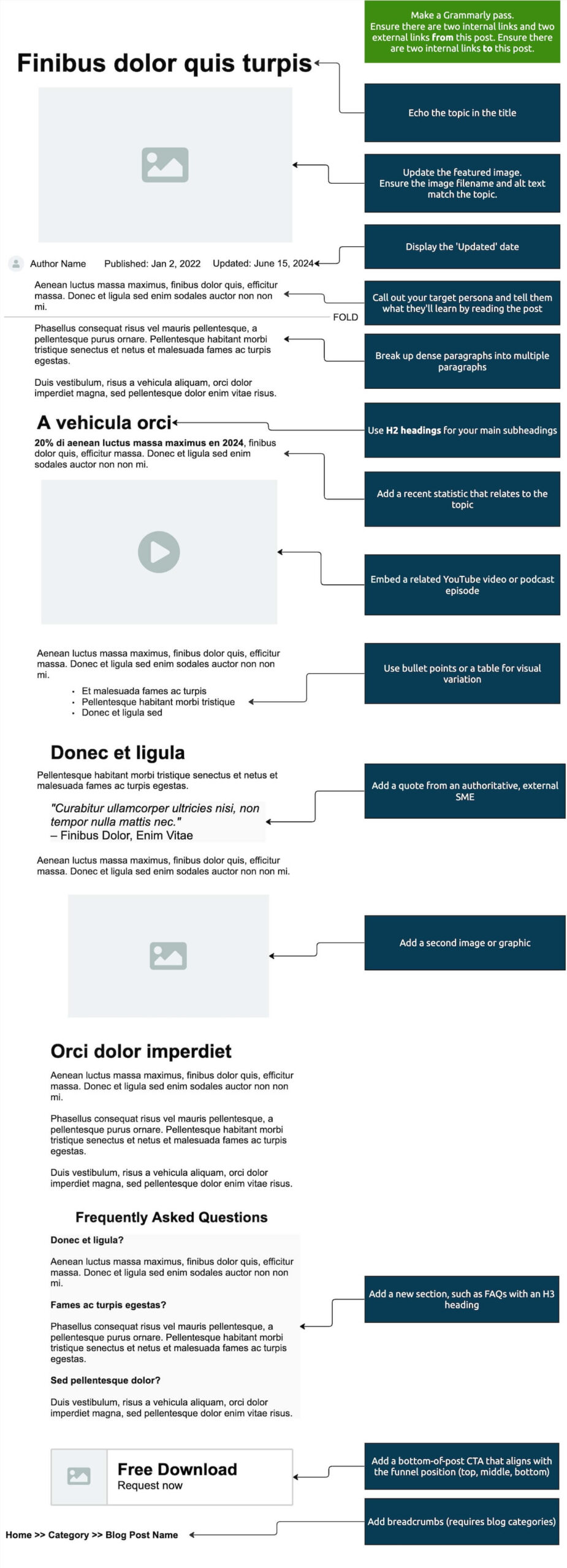NP Digital analyzed websites that consistently increased their SEO traffic by at least 50% yearly for over four years.
The company found that people who managed these websites spent 68.9% of the time updating existing content and 31.1% creating new content.
Use this graphic to guide you in updating your existing content to get more website traffic and increase your content marketing ROI.

Keeping your blog content fresh and relevant is crucial. Updating your blog posts can improve SEO and boost engagement with your readers.
“Pushing publish and then letting your content sit forever is one of the worst mistakes you can make. As your sitting content becomes less relevant, Google will ensure it is less visited.”
Ross Simmonds, author of Create Once, Distribute Forever
The above graphic is a step-by-step guide that lays out the essential steps for updating your blog effectively.
Grammar and Language Optimization
Before making substantive updates, run a Grammarly Premium pass to correct any spelling, grammar, or punctuation errors. This will ensure that your content maintains professionalism and readability.
Refresh Visual Elements
Update the featured images to reflect the current content and ensure that file names and alt text are optimized for SEO. This will make the post more accessible and enhance its visibility in search engine results.
Enhance Structural Elements
Utilize H2 headings for your primary sections to improve readability and SEO. Structuring your content with clear, descriptive headers helps readers navigate the article and improves its performance on search engines.
Incorporate Recent Data and External Insights
Adding recent statistics and quotes from authoritative sources enriches your content and boosts its credibility. This also keeps the information timely and more valuable to your readers.
Embed Multimedia
Incorporating multimedia elements like YouTube videos or podcast episodes can significantly increase user engagement.
This multimedia content can break up text-heavy sections and cater to different learning styles and preferences.
Visual Variation and Accessibility
Breaking up dense paragraphs and employing bullet points or tables helps make the content more accessible and digestible.
Visual variety can hold the reader’s attention longer and make complex information easier to understand.
Call to Action (CTA)
End your post with a solid call to action that aligns with the reader’s position in the marketing funnel.
A well-crafted CTA can convert readers into leads or customers by prompting them to download a resource, read another article, or contact your business.
Add New Sections
Consider adding sections like FAQs to address common questions. This will add value to the reader and target additional keywords, potentially boosting SEO.
Frequently Asked Questions
Updating your existing blog posts can significantly enhance their visibility and performance in search results. Older posts may already have backlinks, shares, and established search rankings. Refreshing them with new information, images, or keywords can improve their relevance and ranking without starting from scratch. This strategy aligns with a broader multi-point SEO approach.
Keyword Cannibalization: Ensure new keywords don’t overlap with others across multiple posts, which can dilute SEO impact.
Content Duplication: Avoid copying and pasting similar content across posts. Instead, focus on unique, high-quality updates.
Ignoring SEO Basics: Ensure proper meta descriptions, internal linking, and image optimization.
Use analytics tools to track the performance of updated posts in terms of search engine rankings, organic traffic, engagement, and conversions. A multi-point inspection will help identify critical areas, like backlinks, content helpfulness, and page performance, to ensure that your updates lead to better results.
The above infographic is a blueprint for business bloggers to revamp their existing content.
By following these steps, you can ensure your blog remains relevant, engaging, and optimized for search engines, extending your posts’ lifecycle and maximizing their impact on your audience.


